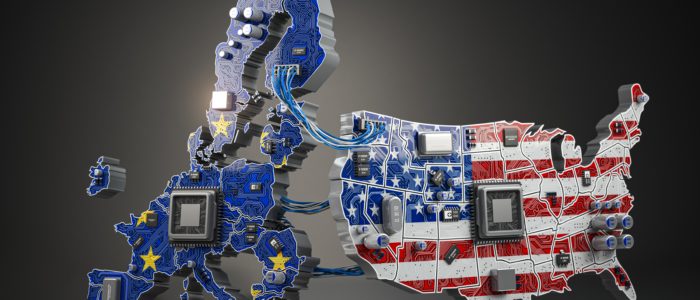Published
Could Digital Cooperation Help De-escalate EU-US Trade Tensions?
By: Guest Author
Subjects: Digital Economy EU Trade Agreements European Union North-America

By Hannes Berggren, Trade Policy Advisor, National Board of Trade
Prior to the US presidential election, Sweden’s National Board of Trade argued in an analysis that the EU-US fragmentation over digital regulation is harmful and unnecessary between two otherwise closely allied partners. We labelled this rift friendmentation and pointed out that addressing it could help both economic and security objectives on both sides of the Atlantic.
We also argued that digital cooperation could be an area for the EU to focus on in its efforts to de-escalate trade tensions with the US. The logic underpinning that argument was that Donald Trump’s first presidential term led to the negotiation of some of the most ambitious US digital trade policy chapters; those in the USMCA and the renegotiated US-Japan agreement. We also noted that the EU have lately adopted many similar digital trade policy commitments with partners such as Japan. Therefore, the EU and the US now have digital trade policy stances that overlap to a fairly large extent.
Since the Presidential inauguration of Donald Trump, global trade tensions have risen, and the private sector is facing increasing uncertainty. US tariffs have been announced and paused for its neighbours Canada and Mexico – and imposed on China. In turn, China has retaliated with tariffs on US goods. Moreover, the US has threatened tariffs on the EU. These tariffs are not only costly, but also undermine the rules-based multilateral trading system.
Tensions have also begun spilling over into services trade, not least digital services. President Trump has threatened to target Brussels in response to fines imposed on US tech companies. The EU, meanwhile, is allegedly preparing to target its anti-coercion instrument on the US digital services sector. While friendmentation grows between the EU and US, China has made yet another stride in AI development with the launch of its DeepSeek model.
Further digital trade friction between the EU and the US will have a real economic cost to both the US and the EU. This is not least true for digitally advanced countries, where companies’ export performance rely partly on digital services inputs that are often delivered by US companies.
At the same time, there are potential areas of cooperation between the EU and the US. Trump’s America First Trade Policy, announced on January 20, tasks the USTR to ‘identify countries with which the United States can negotiate agreements on a bilateral or sector-specific basis’. Similarly, the EU’s recent Competitiveness Compass lays out closing more digital deals as a priority. Moreover, Commissioner Šefčovič has told the European Parliament that the EU should be ready to explore deeper EU-US cooperation on economic security.
In other words, de-escalation by means of a digital agreement that focuses on facilitating digital trade and presents a joint approach to economic security concerns could still be possible. Given that the EU and the US do not have an underlying FTA in place, one key concern for designing such a deal is how to ensure that it aligns with WTO rules (more specifically MFN-compatibility). The way we see it, there are three avenues that could solve this issue.
The first option, which is obviously preferable but also highly unlikely, is negotiating a full-scale EU-US FTA with an ambitious digital chapter.
The second option is looking more closely at the Digital Economy Partnership Agreement (DEPA) as a model. DEPA was originally negotiated between Singapore, New Zealand and Chile as a stand-alone open plurilateral agreement and has since accepted new members such as Costa Rica and the Republic of Korea.
A third option, which is likely to be a faster and easier avenue, is putting together a package of measures that do not constitute binding trade commitments that could come into conflict with existing WTO commitments. Such a package would ideally build on the TTC outcomes as a baseline and maintain ongoing dialogues in those already established working groups. Additionally, such a package would introduce new initiatives to facilitate digital trade and address shared economic security concerns. As such, it could include a politically attractive win for both sides.
Some initial ideas for proposals that might fit into such a package (but would need further evaluation by the European Commission) are:
- Safeguard transatlantic data flows. This could include both parties reconfirming their commitment to the EU-US Data Privacy Framework. Moreover, it could include a finalisation of an e-evidence deal. These two measures could help reduce regulatory uncertainty around diverging data, privacy and law enforcement regulations and thereby help facilitate transatlantic data flows.
- Enhance regulatory cooperation. This could include additional common principles for regulations of relevance to the digital economy, including for example privacy, cybersecurity, and intellectual property. It could also include a mechanism that allows for a period of bilateral comments and discussion of proposed legislations that could impact digital trade.
- Strengthen cooperation on economic security. This could include a deepening of the collaboration on investment screenings and export controls that pertain to the digital economy. It could also include agreeing on a common unrestricted area for leading technologies otherwise covered by export controls. This could reduce the regulatory burden for transatlantic companies and facilitate the EU-US flow of leading technologies such as semiconductors, AI and quantum.
This suggestion to explore the digital economy as a potential area of increased EU-US collaboration does not imply that such an undertaking would be easy or come without political friction. Neither should the above-mentioned ideas be understood as a finalised proposal for an agreement. Instead, it should be understood as an effort to contribute to a discussion that hopefully can help avert a costly EU-US trade war and promote continued transatlantic economic and technological progress. As such, the European Commission should formulate proposals for a package of realistic, commercially relevant and implementable measures that can facilitate transatlantic digital trade.
One response to “Could Digital Cooperation Help De-escalate EU-US Trade Tensions?”